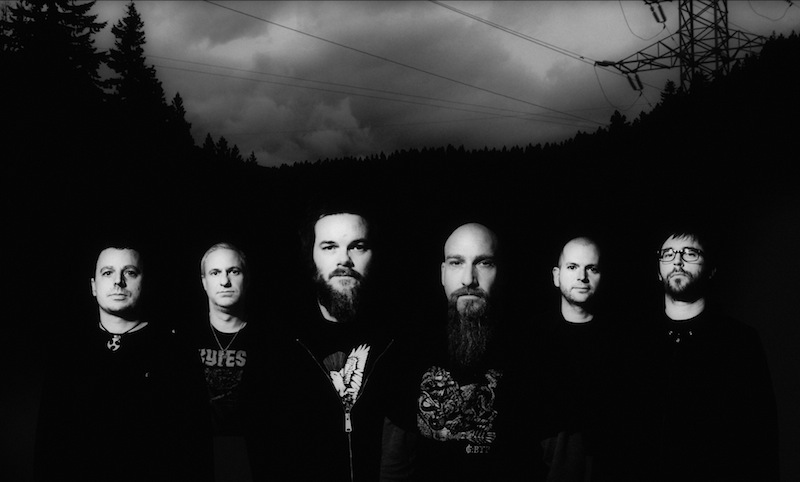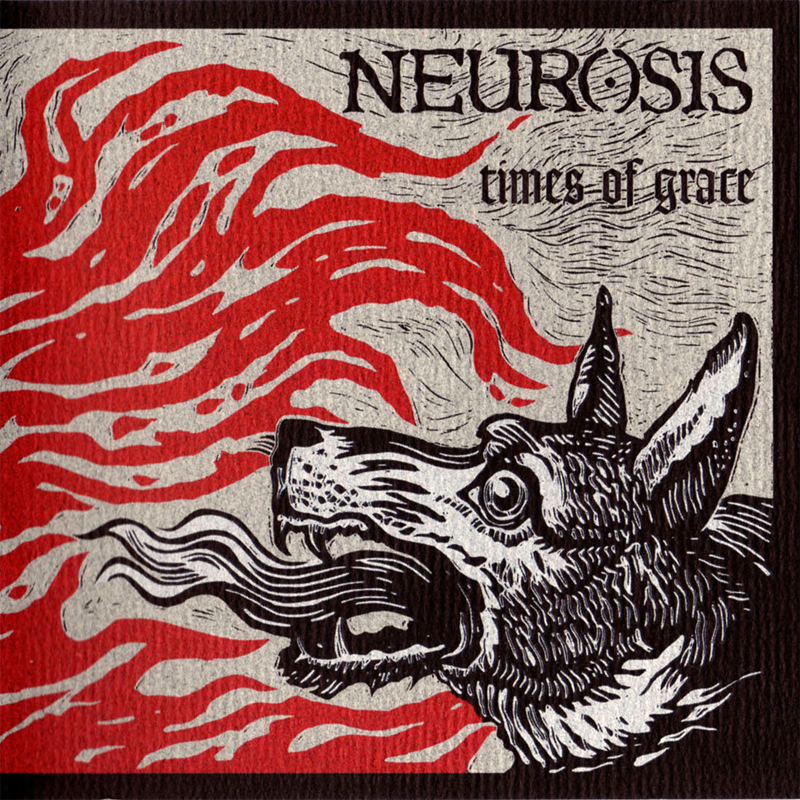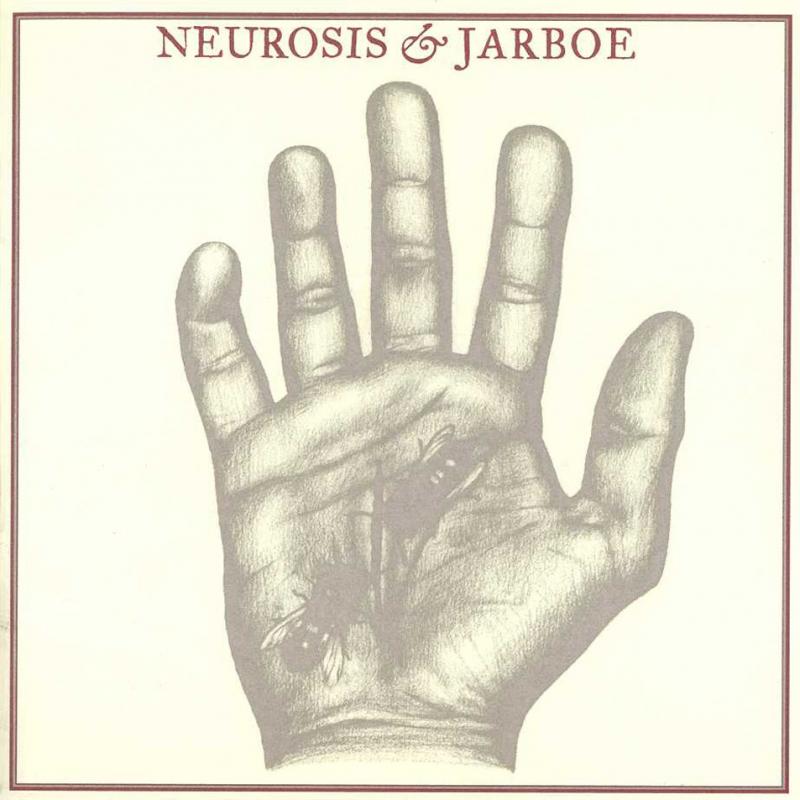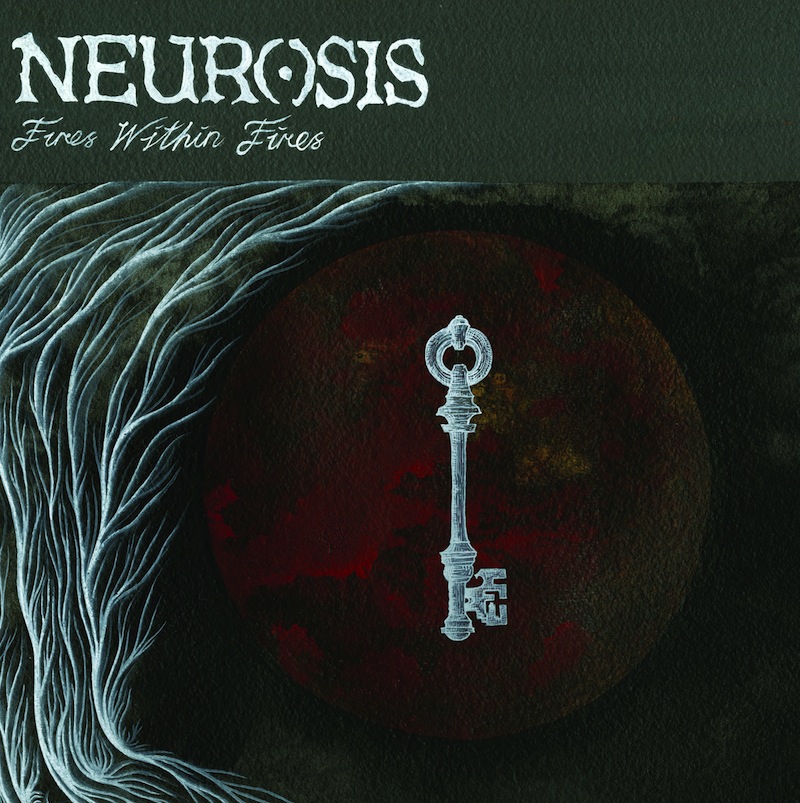Celebrate the Catalog: Neurosis

Twenty years ago, Neurosis changed metal forever by releasing their 1996 album Through Silver in Blood, a 70-plus minute exercise in spiritual exorcism that not only made them legends but helped shape how we now hear heavy music. That anniversary hangs heavy as we approach the release of the band’s new album, Fires Within Fires. And the release of that album comes sandwiched between two other notable anniversaries: Last year was their 30th as a band, while next year will be the 30th of their first release. Neurosis is hitting a lot of milestones these days.
That’s fairly remarkable when you consider Neurosis hasn’t lost any of the menace or drive that’s made them a singular band in heavy music. In their earliest days, they didn’t stand out so strongly, releasing a handful of crossover hardcore records that definitely were loud and fast, but didn’t necessarily set them apart as innovators. In the ’90s, that changed with their continuously evolving sound, growing bigger and meatier, and eventually terrifying in a strange and beautiful way. Moving away from the Bad Brains or Discharge influence of their early records, Neurosis began to move away from a more basic hardcore approach with influences taken from the likes of Swans and Godflesh, all the while exploring all of the open space between Joy Division and Black Sabbath.
Neurosis is as devastating and powerful as they’ve ever sounded, though they’ve covered a lot of ground and made a lot of very different records during their career. As we look forward to the release of their new full-length, join us as we take a journey through their catalog—every album rated and evaluated, from old-school hardcore to a new, frightening art metal future.
1987-1999
 Pain of Mind
Pain of Mind
(1987; Lookout)
It’s a bit strange to imagine Neurosis—heaviest and most apocalyptic of metal bands—once sharing label real estate with Green Day, but Lookout Records was an outpost for all things punk in the Bay Area back in the late ’80s and early ’90s. And Neurosis was more of a punk band than a metal band in their earliest days, kicking up a crossover thrash dust storm that sounded a bit like Amebix, Bad Brains and D.R.I. engaged in a kind of messy, lo-fi hardcore battle royale. In that sense, it’s a fairly fun listen, though in context pretty unremarkable. It has its moments—the four-minute “Black” (which was pretty long for this version of Neurosis) incorporates some college rock guitar jangle into an otherwise loud and aggressive selection of bruisers. Pain of Mind isn’t a bad album by any means; put it on at a skatepark, for instance, and you’ll be stoked to shred the gnar or gleam the cube or whatever half-pipers said back in 1987. But it’s absent much that makes it memorable, and for that matter, doesn’t feel like a fully formed statement. It’s a loud, aggressive set of incendiary punk songs that do the trick quickly. It’s not bad, but it’s not the Neurosis as we know them today.
Rating: 5.0 out of 10
 The Word As Law
The Word As Law
(1990; Lookout)
The Word As Law is the sound of a band in transition. In a few years, they’d manage to set their sights well beyond the fairly limiting crossover thrash hardcore of their debut, yet without quite reaching full songwriting maturity. What that results in is an album that’s pretty long—hitting the 70 minute mark by just their second effort—yet by no means cohesive. There’s no reason for it to be this long; it has a lot of songs, and some of them are pretty good, but it’s a bit all over the place. A handful of songs cross the six-minute mark, offering signals that the Oakland band were interested in pursuing something more epic. Yet they’re frequently at their most memorable when keeping it concise—the 47-second insensitivity is the most fun part of the whole thing. (That sounds a little odd, given who we’re talking about; I enjoy listening to Neurosis a lot, but “fun” just doesn’t quite encapsulate what they do.) It wasn’t actually until the album was released with an EP’s worth of CD bonus tracks that their future direction started to become clearer. The final song on the tracklist is a cover of Joy Division’s “Day of the Lords,” and the combination of their hardcore brawny with a vintage goth-rock dirge is essentially the template for Neurosis songs to come. The last track, however, is a hidden 10-minute feedback exercise, the weirdness of which completes the picture sketched out in the track prior; doomsday sludge is a direction to follow for their songwriting style, but slow moving avant garde noise would be the sound design to put it in proper headphone context. They had the elements, they just had to figure out how to put them together.
Rating: 6.3 out of 10
 Souls at Zero
Souls at Zero
(1992; Alternative Tentacles)
And after five years, Neurosis emerge fully formed, the ferocious beast of a band whose epic dirges have become a signature sound. This is the Neurosis that we know and do our best to understand today. (You can’t fully understand them—they’re too awesome and mystical a force for that, but we at least recognize the triumphant slabs of metal they create.) Informed as much by the churning and physical menace of Swans as the metal and hardcore that influenced their early records, Souls at Zero is at once deeply unsettling and wholly compelling. By slowing their pace and focusing on more intricate details, not to mention a deeper investment into melody and songwriting, Neurosis took a great leap forward through songs such as the gloomy post-punk sludge of “To Crawl Under One’s Skin” or the bad-trip psych metal of the title track. The increased presence of ominous samples and found sounds heighten the atmosphere of terror, and when the band is at their most ambitious, namely the terrifying centerpiece “A Chronology for Survival,” they’re essentially peerless. And this comes just a couple years after two middling hardcore records! I didn’t hear Souls at Zero in 1992, but much later after being won over by the awe-inspiring sounds of Through Silver in Blood and Times of Grace. Still, I can only imagine what it might have been like to hear it at the time. It’s a brutal piece of work.
Rating: 8.9 out of 10
 Enemy of the Sun
Enemy of the Sun
(1993; Alternative Tentacles)
“Cleanse,” the final track on Enemy of the Sun, is a 26-minute exercise of tribal drumming, wordless chants and, um, didgeridoo. It’s a long track, with no guitars, and sounds more like something you’d hear in front of a raging pyre at Burning Man. That doesn’t mean it’s bad, but it’s probably going to be the determining factor in whether or not Enemy of the Sun is your kind of metal album. And to be fair, Neurosis certainly has a weird jam band vibe when it comes to the dedication of their fanbase (though not the music, necessarily, in spite of their song lengths). Yet, the rest of it is essentially classic Neurosis—riffs that shatter the ground beneath you, fearsome bellows, powerful melodic dirges and the curious addition of various non-metal elements, be it found sound or pianos. Yet “Cleanse” comprises a pretty big chunk of the album, so that still skews the percentage a bit. It’s an interesting parallel to the hidden track on Tool’s Undertow, which was released close to the same time, and metal and alternative rock worlds were starting to cross. Neurosis never flirted with commercial appeal, however, so instead of “Sober,” they deliver the white-knuckle intensity of “Cold Ascending,” which is as concise and incendiary a Neurosis song as you’re likely to hear. Enemy of the Sun is the point where Neurosis gives in fully to their endtimes tribe persona, while sounding their sludgiest. It’s an essential link between their early rawness and their later forays into epic soul-destroying art.
Rating: 8.8 out of 10
 Through Silver in Blood
Through Silver in Blood
(1996; Relapse)
Boy, where to begin with this one… well, suppose you needed a soundtrack for the earth open up and swallow you whole. This is probably what you’d reach for. And suppose you needed an album to play to actually bring about such a cataclysmic event—this is still the album you’d reach for. It’s almost spiritual in its powerful, endlessly unfolding sludge metal dirges. To say that Through Silver in Blood is Neurosis’ heaviest album is perhaps an argument of nuance and degree, but it’s no doubt their most massive. The riffs alone—in just the title track no less, as well as more concise highlight “Locust Star“—are devastating like few metal albums can profess to be. But it’s not just the guitars or the drums that make the album a force of nature, though those certainly help. There’s a degree of industrial noise to it all that pushes the album into a genre unto itself. Previously I mentioned that the band shared some similarities with Tool. Here, they surpass anything that Tool was doing and essentially lay out a path for the future of metal. That’s not an understatement, either—listen to records by Mastodon or Isis, early Baroness or Kylesa and countless others, and you’ll hear Neurosis in that crunch. You can’t really overstate the importance of this album, because it’s groundbreaking in its display of physicality and supernaturalism. It’s a beast, but perhaps a mythical one with about a dozen heads that breathe blue flame. Wait, make that silver.
Rating: 10 out of 10
 Times of Grace
Times of Grace
(1999; Relapse)
Every Neurosis album in its most intense moments can feel like the end of the world. But it’s all relative. For instance: Listening to pretty much any of them after Through Silver in Blood seems to lessen the sense of impending doom, if only a little bit. That album is a masterpiece of earth-swallowing terror. And so is Times of Grace, arguably, the band’s close runner up for best album. But being that this is their first recording with Steve Albini, the result ends up feeling a bit more raw and visceral. It’s menacing and direct, but not quite so terrifying. It is, however, incredible. It contains some of the band’s best songs, for starters, be it the emotionally draining dirge “The Last You’ll Know,” the primal pulse of “Under the Surface,” the restrained doom of “Belief” or the slow-motion catastrophe of the title track. It’s beautiful and brutal, and big. But it feels more like a live band crafting something together rather than a mystical work of supernatural forces. That’s the illusion of Through Silver, and it’s one I’d gladly take any time. But there’s something refreshing about the tautness of the performances here, the cleanliness of the recordings and the wonder of hearing one of the greatest metal bands that America’s ever known on top of their game.
Rating: 9.4 out of 10
2001-2012
 A Sun That Never Sets
A Sun That Never Sets
(2001; Relapse)
When Neurosis’ A Sun That Never Sets Was released, it received some middling reviews, in part because the band had to some degree tempered the crushing sound that characterized essentially the whole of their output during the ’90s. Yet, by contrast, it’s grown over the past 15 years to become a cult favorite among fans. At the risk of giving away too much too soon, however, I’ll just go ahead and say that, after their first few records of still-crystallizing hardcore beatdowns, Neurosis didn’t release any bad albums. Even those aren’t total shit, just underwhelming and basic when held against the most experimental and ambitious of what they’d later release. Where A Sun That Never Sets likely felt a bit like a letdown is in its more hushed tones. Scott Kelly and Steve Von Till began to incorporate more of a folk influence into their songwriting, and while the music itself isn’t really folk, per se, the softer tones and atmospheric space within the songs on the album meant less of the urgency that marked its predecessor Times of Grace, which was also recorded by Steve Albini. Albini’s signature drum thwack is here, of course, but the songs move with fewer climaxes, a fairly short and digestible piece like the title track more open and meditative than, say, “Locust Star.” By contrast, the gradual evolution of the 13-minute “Falling Unknown,” complete with mournful strings, puts the band closer to Godspeed You! Black Emperor than Melvins, and the slow burn of the title track is chilling. And there’s something uplifting and ascendant about the almost Lungfish-like “Crawl Back In.” A Sun That Never Sets doesn’t hit as hard as many of Neurosis’ other albums, and as such is less immediate. Where it makes up for that is in being one of their most interesting. Every listen reveals something new.
Rating: 8.7 out of 10
 Neurosis & Jarboe
Neurosis & Jarboe
(2003; Neurot)
Given Neurosis’ background and history, and undeniable Swans influence, it was probably inevitable that they’d end up recording something with Jarboe. And it sounds more or less like you might expect it sound—Neurosis playing heavy, epic backing band for Jarboe’s versatile and terrifying vocal presence. That being said, it’s more of a Jarboe album than a Neurosis album, at least in terms of the aesthetic. It’s beautiful and strange and difficult to get one’s head around on a first listen. Or a second listen. It’s one of the less accessible Neurosis albums in (relatively) recent years, and it’s built on more ethereal structures with a heavy emphasis on repetition. Which isn’t to say there aren’t many rewarding moments. But it’s not an easy listen. And that’s a good thing. The last thing you’d want for Neurosis is to get too comfortable.
Rating: 7.0 out of 10
 The Eye of Every Storm
The Eye of Every Storm
(2004; Relapse)
Following A Sun That Never Sets and the band’s collaboration with Jarboe, Neurosis continued down the dark path laid out before them since they found their direction on 1992’s Souls at Zero. Yet that darkness has taken on a variety of different shapes, be it terrifying and massive on Through Silver In Blood or soulful and melancholic on A Sun That Never Sets. In fact, most of their recordings lean much closer toward the former than the latter, with varying degrees of dynamics, volume or sonic treatment. The Eye of Every Storm is a different beast altogether. It sounds like Neurosis, sure—the powerful opening dirge “Burn” is one of their strongest songs and an immediately gripping opening. Like A Sun, however, The Eye of Every Storm is an album that warrants closer attention and repeat listen before it really takes hold. It is, arguably, the band’s prettiest album. But it’s a bleak prettiness, their epic compositions fit to score a psychological horror rather than a supernatural one. This isn’t volcanoes swallowing people whole, it’s the feeling of despair deep within your soul and a pervasive sense of desolation. And it’s loud and heavy in its climactic moments, but much of the album is about letting open spaces speak for themselves, for minor chords to land and ring into the emptiness. It’s not an easy listen by any means, but it’s without question the band’s prettiest album.
Rating: 9.0 out of 10
 Given to the Rising
Given to the Rising
(2007; Neurot)
While Neurosis’ 2007 album Given to the Rising doesn’t quite have the historic reputation that Times of Grace or The Eye of Every Storm does, in time (and probably soon, given its 10th anniversary is around the corner) it’s likely to warrant a similar reputation. Of the post-millennial Neurosis albums, it’s the one with the most experimentation, the widest display of dynamics and the greatest ambition. While it’s not as quiet or as subdued as A Sun That Never Sets, there’s a similar sense of restraint at play. The band detonates their sonic explosions where they need to, but rather than maintain an endurance test like that of their albums released in the ’90s, they arrive between moments of eerie stillness, with an almost avant garde compositional approach that allow them to sustain dissonant chords or chilling ambient spaces. There’s more synth, more passages of spoken word from Scott Kelly (who at this point is sort of like a metal Tom Waits in his signature growl) and a great deal of beauty throughout. On a track like “Hidden Faces,” they still rip without reservation, but the most breathtaking moments are those such as “To the Wind,” wherein Neurosis displays the glacial grace of prime Sigur Rós.
Rating: 9.1 out of 10
 Honor Found in Decay
Honor Found in Decay
(2012; Neurot)
In early 2013, Steve Von Till said in a Decibel interview that Neurosis’ records weren’t the type of sounds you’d put on if you were throwing a party, and he’s absolutely right. Their music is alternately harrowing and desolate, destructive and fragile—in my own review of Honor Found in Decay back in 2012, I couldn’t help but draw parallels to the pre-apocalypse tension that was going around (erroneously, but still). It feels more like the aftermath than the act of destruction, however—the smoldering crater more than the meteor making its impact. Scott Kelly’s deep, growling presence sounds more grizzled than usual, which suits the music splendidly. There’s an overall sense of doom and dread that can’t be shaken, though in key moments, notably the urgent “All Is Found…In Time” and the opening bombast of “We All Rage In Blood,” the band rocks pretty hard. Much of Honor‘s character is in the nuances and the moments that take their time to resolve. It’s for that reason that it’s likely few fans’ first Neurosis album to reach for, but one worth returning to over time to crack its unsettling code.
Rating: 8.4 out of 10
 Fires Within Fires
Fires Within Fires
(2016; Neurot)
Twenty years after the release of Through Silver In Blood, Neurosis didn’t really have to prove anything to anyone. They’re still touring, still playing as loud and as ominously as ever, but as elder statesmen responsible for some of the greatest metal albums of all time, their legacy is cemented. As such, Fires Within Fires didn’t have to be a game-changer. Even if it were, would anyone notice? Unlikely; canons are hard to break. And yet, it’s as strong as anything they’ve released in the 21st century. While it doesn’t have the earthy sprawl of A Sun That Never Sets or the apocalyptic post-rock atmosphere of The Eye of Every Storm, it’s the loosest they’ve sounded in a long time, which isn’t to say that they recaptured their hardcore roots. But on a track like “Fire Is The End Lesson,” they display a punchy immediacy that’s sometimes lost within their more conceptual pieces. And yet, there’s a simple, accessible beauty to much of the album, particularly on the stunning “Broken Ground” and the sprawling, psychedelic “Reach.” With only five tracks, it’s the shortest Neurosis album in a long time, but by keeping it lean, they end up sounding that much stronger.
Rating: 8.9 out of 10
Jeff Terich is the founder and editor of Treble. He's been writing about music for 20 years and has been published at American Songwriter, Bandcamp Daily, Reverb, Spin, Stereogum, uDiscoverMusic, VinylMePlease and some others that he's forgetting right now. He's still not tired of it.


 Pain of Mind
Pain of Mind The Word As Law
The Word As Law Souls at Zero
Souls at Zero Enemy of the Sun
Enemy of the Sun Through Silver in Blood
Through Silver in Blood Times of Grace
Times of Grace A Sun That Never Sets
A Sun That Never Sets Neurosis & Jarboe
Neurosis & Jarboe The Eye of Every Storm
The Eye of Every Storm Given to the Rising
Given to the Rising Honor Found in Decay
Honor Found in Decay Fires Within Fires
Fires Within Fires